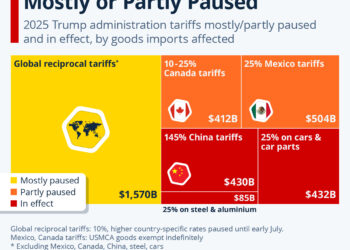Global Economic Outlook: OECD’s Projections for 2025 and 2026
The Organization for Economic Cooperation and Development (OECD) recently released its economic outlook, revealing troubling signs in the global economic landscape. The report, published on January 9, 2025, highlights substantial downward revisions in global growth projections for the years 2025 and 2026. These adjustments reflect ongoing political and economic uncertainties that are reshaping investment and consumption patterns worldwide.
Revised Global GDP Growth Projections
Key Changes in Projections
In its latest appraisal, the OECD downgraded the anticipated global GDP growth for 2025 from an earlier estimate of 3.3% to 3.1%. Similarly, the forecast for 2026 was also reduced from 3.3% to 3.0%. This cautious outlook underscores the challenges that economies face as they navigate a complex international environment.
Factors Behind Downgrades
Lingering Inflation
One of the central themes affecting economic growth is persistent inflation. As consumers and businesses adjust to rising prices, spending patterns become more conservative, influencing overall economic momentum. The OECD’s outlook emphasizes how inflation continues to pose a significant risk not only to macroeconomic stability but also to individual purchasing power.
Increased Trade Barriers
Another critical factor contributing to the downward revision is the rise of trade barriers. The OECD highlights that any further escalation in trade restrictions, particularly tariffs, can significantly hinder global economic growth. The imposition of new tariffs not only disrupts international supply chains but also reduces trade flows, which are vital for economic growth.
The Impact of Trade Wars
Potential Consequences of Increased Tariffs
The OECD’s report provides alarming insights into how trade wars could unfold in the coming years. For instance, a hypothetical 10% increase in tariffs on all non-commodity imports to the United States, matched by equivalent tariffs on imports from the U.S., could trigger a decline in global GDP by approximately 0.3% by the third year compared to baseline projections.
Regional Impacts
The study reveals that the United States, alongside its North American trade partners—Canada and Mexico—would be disproportionately affected by these trade tensions. The potential GDP losses projected for these countries are striking: the U.S. could see a reduction of 0.7%, Canada 0.6%, and Mexico a staggering 1.3%. Such estimations indicate that the ramifications of a trade war extend beyond tariffs, affecting overall economic health.
Inflationary Pressures from Tariffs
Increased Inflation Rates
In addition to the GDP implications, the OECD’s outlook addresses the inflationary effects of increased tariffs. It predicts that an additional 10% increase in tariffs could lead to a rise in global inflation by 0.4 percentage points annually for the first three years. In the United States specifically, inflation could spike even more, potentially increasing by 0.7 percentage points per year in response to new tariffs.
Consequences for Consumers
The inflationary pressures driven by tariffs can pose serious challenges for consumers and businesses alike. Increased prices can stifle consumer spending, leading to a compounding effect on economic growth. As consumers face higher costs, their ability to make discretionary purchases diminishes, thereby affecting overall economic vitality.
The Trade War Dilemma
No Winners in a Trade War
The overarching message from the OECD’s findings is clear: there are no winners in a trade war. The affected countries, particularly those imposing tariffs, are likely to face significant economic drawbacks. The report underscores the paradox of protectionist policies, which, while aimed at bolstering domestic industries, can ultimately hinder economic growth.
U.S. as a Major Loser
Amidst this backdrop, the United States emerges as one of the biggest potential losers from a trade war. The report illustrates how the U.S. is not only at risk of facing reduced GDP growth and heightened inflation but also of undermining its own economic stability in the longer term.
Conclusion on the Trade Tensions’ Broader Implications
The OECD’s recent economic outlook serves as a sobering reminder of the interconnectedness of global economies. As trade tensions simmer and uncertainties proliferate, the implications for growth, inflation, and consumer welfare become increasingly pronounced. Understanding these dynamics is crucial for policymakers, businesses, and consumers alike as they navigate the complexities of an evolving economic landscape.





